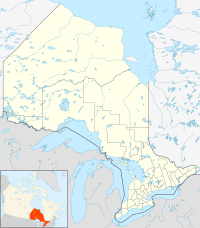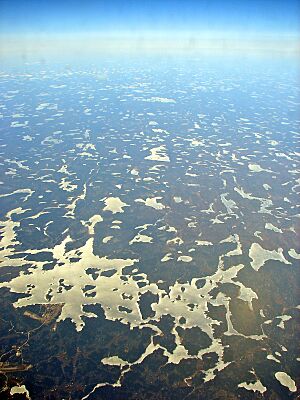Kingfisher First Nation facts for kids
| Province | Ontario |
|---|---|
| Population (2022) | |
| On reserve | 563 |
| On other land | 10 |
| Off reserve | 57 |
| Total population | 630 |
| Tribal Council | |
| Shibogama First Nations Council | |
The Kingfisher First Nation is a community of Oji-Cree people in Ontario, Canada. Their traditional name in the Oji-Cree language is Giishkimanisiiwaaboong, which means "At Kingfisher-waters."
This First Nation has a special land area called a reserve. It is about 350 kilometres (220 mi) north of Sioux Lookout, Ontario. You can reach the community by plane all year. In summer, you can also travel by water. In winter, they use ice roads.
As of 2009, about 500 people were registered members of the First Nation. Most of them lived on the reserve. The people in the community speak Oji-Cree. Many also speak English. The Nishnawbe-Aski Police Service helps keep the community safe.
Contents
History of Kingfisher First Nation
Early Trading and Community Life
A long time ago, in 1808, the Hudson's Bay Company set up a trading post. It was called Big Beaver House. This post was about 12 kilometres southwest of where the Kingfisher Lake reserve is now.
People from Kingfisher Lake often visited Big Beaver House. They went there to trade furs. It was also a place for community activities. Many people found work there, helping to move goods.
Joining Treaty 9
Between 1929 and 1930, the leaders of Kingfisher Lake First Nation had to travel. They went to Big Trout Lake. There, they signed an agreement to join Treaty 9. Because of this, Kingfisher Lake was seen as part of the Big Trout Lake Band.
Changes to Hunting Areas
In 1947, the government in Ontario started a new program. It was called the Trapline Registration and Fee Program. This program made the Kingfisher Lake people map out their traditional hunting areas. They had to pay fees to use these lands.
Establishing a Permanent Home
In 1964, the leaders of Kingfisher Lake made an important decision. They chose to create a permanent community. They moved to the place where the reserve lands are today. Since Kingfisher Lake was already part of the Big Trout Lake Band, it already had reserve status. In 1975, they officially became their own First Nation band.
Community Support During Forest Fires
In 2011, there were big forest fires near the community. Many people had to leave their homes. They were temporarily moved to Ottawa for safety.
How Kingfisher First Nation is Governed
The Kingfisher First Nation chooses its leaders through a special system. This is called the Custom Electoral System. Leaders are elected for a two-year term.
The community's council includes a Chief and a Deputy Chief. There are also three Councillors. As of the original text, the Chief was Lott Sainnawap. The Deputy Chief was Eddie Mamakwa. The Councillors were Amos Mamakwa, Esther Sakakeep, and Samuel Sturgeon.
Kingfisher First Nation is part of two larger groups:
- The Shibogama First Nations Council: This is a group of regional Chiefs.
- The Nishnawbe Aski Nation: This is a larger organization. It represents most of the First Nations in northern Ontario.
Kingfisher First Nation Reserves
The Kingfisher First Nation has three special land areas set aside for them. These are called Indian Reserves:
- Kingfisher Lake 1 Indian Reserve: This is their main reserve. It covers about 596 hectares (1,470 acres). The community of Kingfisher Lake is located here.
- Kingfisher 2A Indian Reserve: This reserve is much larger, covering about 5,444.7 hectares (13,454 acres).
- Kingfisher 3A Indian Reserve: This reserve is about 921.9 hectares (2,278 acres) in size.



